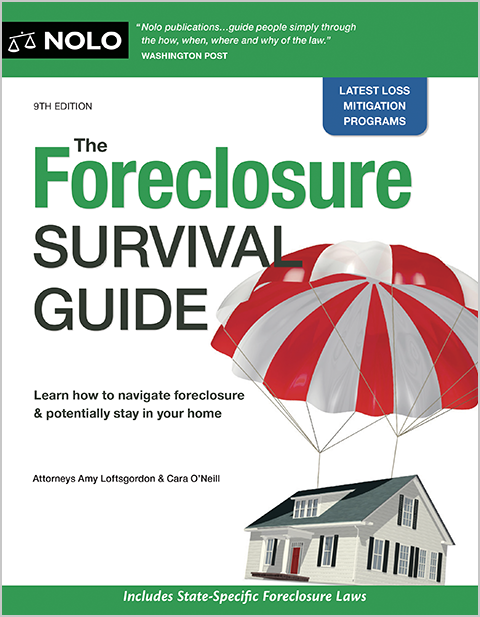Learn how foreclosure works in your state.
If you're behind on mortgage payments or facing the possibility of foreclosure, you should understand your foreclosure rights and how the foreclosure process works in your state. State foreclosure laws determine everything from the type of foreclosure (judicial or nonjudicial) to your ability to reinstate your mortgage, get your home back during a post-sale a redemption period, or avoid a deficiency judgment.
Because laws and timelines vary widely from state to state, knowing the specific rules where you live can make a significant difference in protecting your home and finances. In the chart below, you'll find state-by-state foreclosure laws, plus foreclosure information for the District of Columbia. You can also get links to articles with details about foreclosure procedures in your state by clicking on your state's name.
Foreclosure Process Overview: Key Information by State
For each state and the District of Columbia, the foreclosure chart below provides the following information:
Judicial vs. Nonjudicial Foreclosure: Which Process Your State Uses
A foreclosure can be either:
- judicial (the foreclosing party files a lawsuit, and the case goes through the court system) or
- nonjudicial (the foreclosing party follows a set of state-specific, out-of-court procedural steps to foreclose).
In some states, foreclosures are always judicial. In other states, the foreclosure may be either judicial or nonjudicial; in those states, usually, one or the other is more commonly used. The chart below says which process is used most often in a particular state.
Deficiency Judgment After Foreclosure: Is It Allowed in Your State?
When a house is sold at a foreclosure sale for less than the amount of the outstanding mortgage debt, the difference between the total debt and the foreclosure sale price is called the "deficiency."
For example, say you owe $300,000 on your mortgage loan, and the home is sold at a foreclosure sale for $250,000. The deficiency is $50,000. Some states let the foreclosing party get a personal judgment (called a "deficiency judgment") against the borrower for this amount, while other states prohibit deficiency judgments under particular circumstances.
In the chart below, this column states whether a deficiency judgment is allowed during or after the most commonly used foreclosure procedure for that particular state.
Foreclosure Redemption Period: Can You Buy Back Your Home?
Certain states give foreclosed homeowners a "redemption period" to buy back or "redeem" the property after a foreclosure. To redeem, depending on state law, you'll either have to reimburse the purchaser for the amount paid at the sale, plus allowable costs, or repay the total mortgage debt, plus interest and expenses.
The chart below shows whether a borrower gets a redemption period after the most commonly used foreclosure procedure in each state.
Right to Reinstate Mortgage Before Foreclosure Sale
A "reinstatement" occurs when the borrower brings the delinquent loan current in one payment by paying the overdue payments plus fees and expenses incurred due to the default. Once the loan is reinstated, the borrower resumes making regular payments on the debt.
In a foreclosure, state law sometimes gives a borrower the right to reinstate up until a specific deadline. Even if state law doesn't give you the right to reinstate, your mortgage or deed of trust might provide this right. Or your lender might agree to let you reinstate the loan.
In the chart below, this column indicates whether state law provides a reinstatement right during the most commonly used foreclosure procedure for that particular state.
Foreclosure Laws by State: What to Keep in Mind When Reviewing the Chart
As you review the following chart, keep the following in mind.
The foreclosure information in the chart summarizes your state's laws. It gives only basic information about the key aspects of foreclosure law in the states and District of Columbia for the foreclosure process listed (nonjudicial or judicial). For more details about the process, read the state-specific articles covering foreclosure laws in your state (see links below). Also, the information is intended for owners of single-family residences and it generally doesn't address special laws, such as those for agricultural land or the rights of tenants in landlord-owned foreclosed homes.
Laws change. Statutes change, so checking them is always a good idea. How courts and agencies interpret and apply laws can change. And some rules can even vary within a state. These are just some of the reasons to consider consulting a lawyer if you're facing a foreclosure.
The information likely discusses only your state's most common foreclosure method. For example, the chart could provide information about nonjudicial foreclosures for the states where that is the most common procedure, even though judicial foreclosures are also allowed.
You can do additional research or ask a lawyer to get more information. You should use this information as a starting point for additional research. To find out specific information about foreclosure laws in your state and how they apply to your particular situation, consult a local foreclosure attorney.
50-State Chart of Foreclosure Laws
Clink on the provided links to get detailed information about foreclosure procedures in your state.
|
State |
Common foreclosure process |
Deficiency judgment allowed? |
Redemption allowed after sale? |
Reinstatement available under state law? |
|
Nonjudicial |
Yes |
No |
||
|
Nonjudicial |
No |
Not available after a nonjudicial foreclosure, unless the |
Available any time before sale, but lender can refuse to |
|
|
Nonjudicial |
No |
Available until 5:00 p.m. on the day before date of sale |
||
|
Nonjudicial |
Yes |
No |
Allowed prior to sale |
|
|
Nonjudicial |
No |
Allowed up to five business days before the sale date |
||
|
Nonjudicial |
Yes |
No |
Available until noon the day before the sale provided the |
|
|
Judicial (strict foreclosure or foreclosure by sale) |
Strict foreclosure: until Law Day Foreclosure by sale: until court confirms the sale |
No |
||
|
Judicial |
Yes |
Yes (up until court confirms the sale) |
No |
|
|
Nonjudicial (However, to avoid the District of Columbia's mediation program and due to other factors, lenders sometimes choose the judicial process.) |
Yes |
No |
Allowed up to five business days before the sale, once in two consecutive years |
|
|
Judicial |
No |
|||
|
Nonjudicial |
No |
High-cost home loans may be reinstated until title is transferred |
||
|
Judicial (In the past, most foreclosures in Hawaii were nonjudicial. However, some lenders have switched to judicial foreclosures to bypass Hawaii's Mortgage Foreclosure Dispute Resolution Program. Also, a nonjudicial foreclosure can be converted to a judicial foreclosure in some instances.) |
Yes |
No |
No |
|
|
Nonjudicial |
Yes |
No |
Available within 115 days after notice of default is filed with county recorder |
|
|
Judicial |
Yes, if borrower is personally served or enters an appearance in the action |
Available within 90 days after foreclosure complaint is served |
||
|
Judicial |
No |
If the borrower reinstates before the court enters judgment, the foreclosure must be dismissed. If the borrower reinstates |
||
|
Judicial |
Sometimes |
Sometimes |
Available within 30 days after notice of default if the land is |
|
|
Judicial |
Yes, unless borrower is served by publication and does not appear in the action |
Yes |
No |
|
|
Judicial |
Yes, generally |
Sometimes |
Generally, no right to reinstate (except as permitted by |
|
|
Judicial (executory proceeding) |
No |
No |
||
|
Judicial |
Yes |
No |
Borrower has the right to reinstate within 35 days after |
|
|
Nonjudicial (court must ratify) |
Yes |
Available until one day before sale date |
||
|
Nonjudicial |
Yes |
90-day right to cure |
||
|
Nonjudicial |
No |
|||
|
Nonjudicial |
Yes |
Available any time before the foreclosure sale |
||
|
Nonjudicial |
Yes |
No |
Available at any time before the sale |
|
|
Nonjudicial |
Sometimes |
No |
||
|
Nonjudicial under Small Tract Financing Act |
No (in most cases) |
No (in most cases) |
Any time prior to sale under the Small Tract Financing |
|
|
Nonjudicial |
Yes |
No |
Borrower may reinstate by paying amount due within |
|
|
Nonjudicial |
Yes (but not in certain cases) |
No |
Borrower may reinstate up to five days prior to sale |
|
|
Nonjudicial |
Yes |
No |
No |
|
|
Judicial |
Yes, up until court confirms the sale or if lender gets a deficiency judgment |
Available up to date of final judgment of foreclosure. |
||
|
Judicial |
Yes |
Yes |
||
|
Judicial |
Available any time before final foreclosure judgment |
|||
|
Nonjudicial |
Yes, during the upset bid period (initial upset-bid period lasts for 10 days after the report of sale is filed) |
No |
||
|
Judicial |
Yes, but not for most owner-occupied homes |
Yes (but not abandoned properties) |
Available within 30 days after service of the notice before foreclosure |
|
|
Judicial |
Yes, up until the court confirms the sale |
No |
||
|
Judicial |
No |
|||
|
Nonjudicial |
No |
Available up to five days before sale. The law limits the |
||
|
Judicial |
Yes |
No |
Available until one hour before the bidding at the |
|
|
Nonjudicial |
Yes |
No |
No |
|
|
Judicial |
No, but if lender seeks a deficiency judgment, then borrower can make an upset bid during 30-day period following sale |
No |
||
|
Nonjudicial |
Yes |
Yes |
No (unless the mortgage is a short-term redemption mortgage, then 20 days before acceleration) |
|
|
Nonjudicial |
Yes, unless loan documents waive right to redeem |
No (except in the case of a high-cost |
||
|
Nonjudicial |
No |
Available within 20 days after foreclosing party serves (mails) the notice of default |
||
|
Nonjudicial |
Yes |
No |
Available for three months after notice of default is |
|
|
Judicial (foreclosure by judicial sale or strict foreclosure) |
Yes |
Foreclosure by judical sale: redemption period is prior to sale Strict foreclosure: yes, after foreclosure decree |
Available upon agreement before sale |
|
|
Nonjudicial |
No |
No |
||
|
Nonjudicial |
Available up to 11 days before sale |
|||
|
Nonjudicial |
No |
Notice of default must give the borrower ten days to cure the default and reinstate the loan. The borrower |
||
|
Judicial |
Available any time before judgment. Borrowers may |
|||
|
Nonjudicial |
Yes |
Yes |
No |

